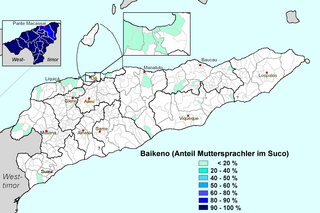Uab Meto language
| Uab Meto | |
|---|---|
| Uab Metô | |
| Native to | Indonesia, East Timor |
| Region | West Timor, Oecusse |
Native speakers | 800,000 (2009–2011)[1] |
Austronesian
| |
| Official status | |
Recognised minority language in | |
| Language codes | |
| ISO 639-3 | Either:aoz – Uab Metobkx – Baikeno |
| Glottolog | uabm1237 |
| ELP | Uab Meto |
| Baikeno[2] | |
 | |

Uab Meto or Dawan is an Austronesian language spoken by Atoni people of West Timor. The language has a variant spoken in the East Timorese exclave of Oecussi-Ambeno, called Baikenu. Baikenu uses words derived from Portuguese, for example, obrigadu for 'thank you', instead of the Indonesian terima kasih.[4]
Phonology
Dawan has the following consonants and vowels:[5]
| Labial | Alveolar | Velar | Glottal | ||
|---|---|---|---|---|---|
| Plosive | voiceless | p | t | k | ʔ |
| voiced | b | ||||
| Nasal | m | n | |||
| Fricative | f | s | h | ||
| Lateral | l | ||||
Voiceless plosives [p t k] can have unreleased allophones [p̚ t̚ k̚] in word-final position. A phonemic /r/ can be heard in place of /l/ among dialects.[6]
| Front | Back | |
|---|---|---|
| High | i | u |
| Mid | e | o |
| ɛ | ɔ | |
| Low | a | |
Vocabulary
A wordlist of 200 basic vocabulary items is available at the Austronesian Basic Vocabulary Database,[7] with data provided by Robert Blust and from Edwards (2016).[8]
| Uab Meto | English |
|---|---|
| Pah (polite), Tua (polite), Hao (normal), He’ (informal), Ya (normal) | Yes |
| Kaha’, Kahfa’ | No |
| Nek seun banit (in West Timor) | Thank you |
| Obrigadu (in East Timor) | Thank you |
| Nek seunbanit namfau/´naek’, Terimakasih ‘nanaek (in West Timor) | Thank you very much |
| Obrigadu namfau’ (in East Timor) | Thank you very much |
| Sama-sama, leko, naleok | You are welcome |
| Neu’ | Please |
| Maaf, permisi, parmis | Excuse me |
| Halo, Tabe | Hello |
| Tkoenok tem pa´ | Welcome, please come in |
| Tkoenok pa´ (to say good bye to one who leaves) | Good bye |
| Selamat tinggal (said to one staying) | Good bye |
| Selamat Jalan (said to one leaving) | Good bye |
Numbers
| Uab Meto | English |
|---|---|
| Nol, Luman | Zero |
| Mese' | One |
| Nua | Two |
| Teun | Three |
| Haa | Four |
| Niim | Five |
| Nee | Six |
| Hiut | Seven |
| Faun, Faon | Eight |
| Sio | Nine |
| Bo'-, Bo'es | Ten |
| Bo'es-am-mese' | Eleven |
| Bo'es-am-nua | Twelve |
| Bo'es-am-teun | Thirteen |
| Bo'es-am-haa | Fourteen |
| Bo'es-am-niim | Fifteen |
| Bo'es-am-nee | Sixteen |
| Bo'es-am-hiut | Seventeen |
| Bo'es-am-faun | Eighteen |
| Bo'es-am-sio | Nineteen |
| Bo'nua | Twenty |
| Bo'nua-m-mese' | Twenty-one |
| Bo'teun | Thirty |
| Bo'haa | Forty |
| Bo'niim | Fifty |
| Bo'nee | Sixty |
| Bo'hiut | Seventy |
| Bo'faun | Eighty |
| Bo'sio | Ninety |
| Natun mese', Nautnes | One hundred |
| Nifun mese', Niufnes | One thousand |
| Juta mese', Juta es, Juutes | One million |
See also
References
- ^ Uab Meto at Ethnologue (18th ed., 2015) (subscription required)
Baikeno at Ethnologue (18th ed., 2015) (subscription required) - ^ Endangered Languages Project data for Baikeno.
- ^ Edwards, Owen (2020). Metathesis and Unmetathesis in Amarasi. Berlin: Language Science Press. doi:10.5281/zenodo.3700413. ISBN 978-3-96110-223-5.
- ^ "Dawan (Uab Meto)". omniglot.com.
- ^ Tarno et al. (1992)
- ^ Edwards (2016), pp. 71–72
- ^ "Uab Meto Wordlist". Austronesian Basic Vocabulary Database.
- ^ Edwards (2016), pp. 79–85
Further reading
- Edwards, Owen (2016). "Parallel Sound Correspondences in Uab Meto". Oceanic Linguistics. 55 (1): 52–86. doi:10.1353/ol.2016.0008. hdl:1885/108661 – via Australian National University.
- Middelkoop, P. (1950). "Proeve van een Timorese Grammatica" [A Trial Timorese Grammar]. Bijdragen tot de Taal-, Land- en Volkenkunde (in Dutch). 106 (3): 375–517. doi:10.1163/22134379-90002474.
- Tarno; Wakidi; S.J. Mboeik; P. Sawardo; S. Kusharyanto (1992). Tata Bahasa Dawan [Dawan Grammar] (in Indonesian). Jakarta: Pusal Pembinaan dan Pengembangan Bahasa. ISBN 979-459-206-4 – via Repositori Institusi Kementerian Pendidikan dan Kebudayaan.
External links
